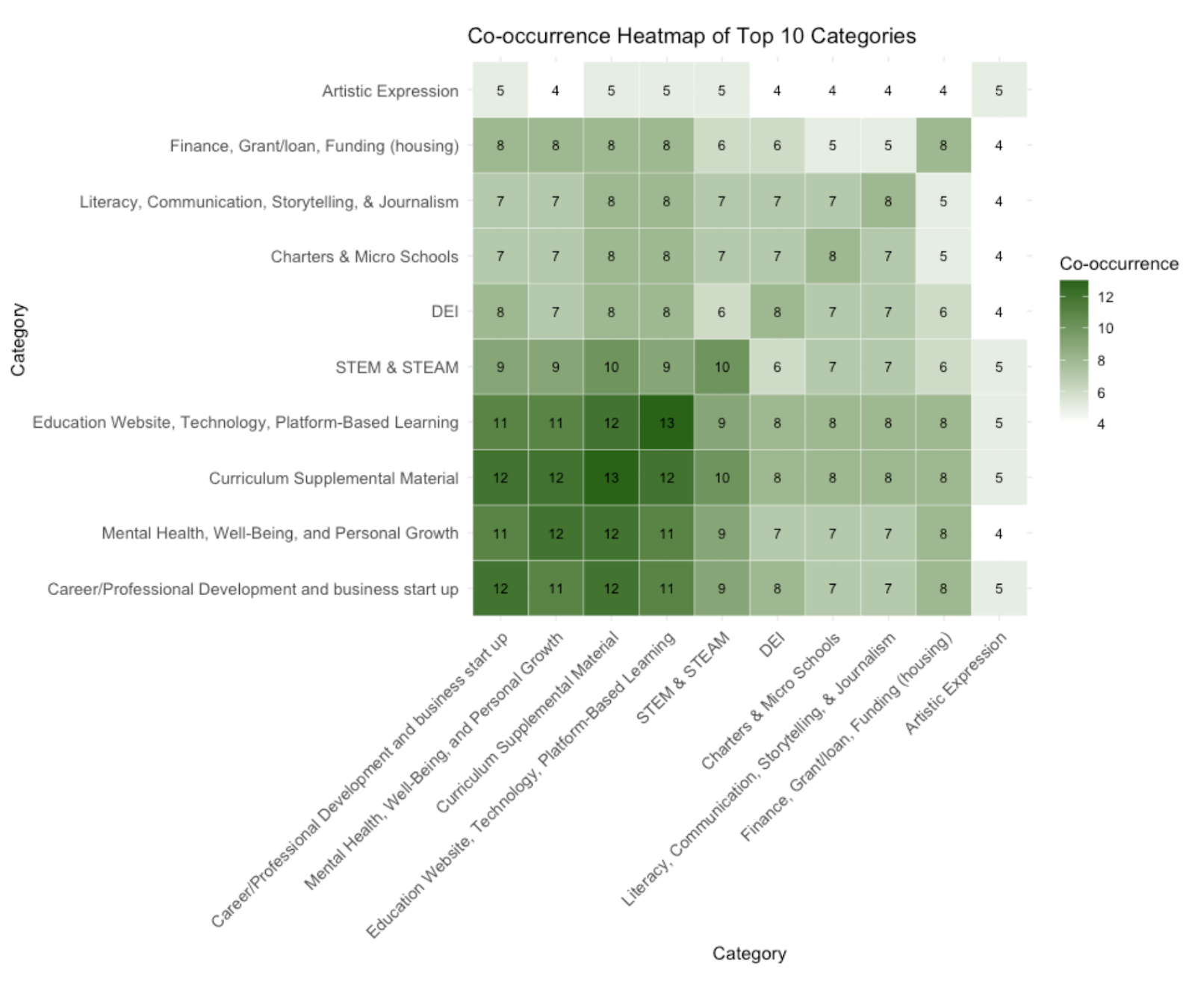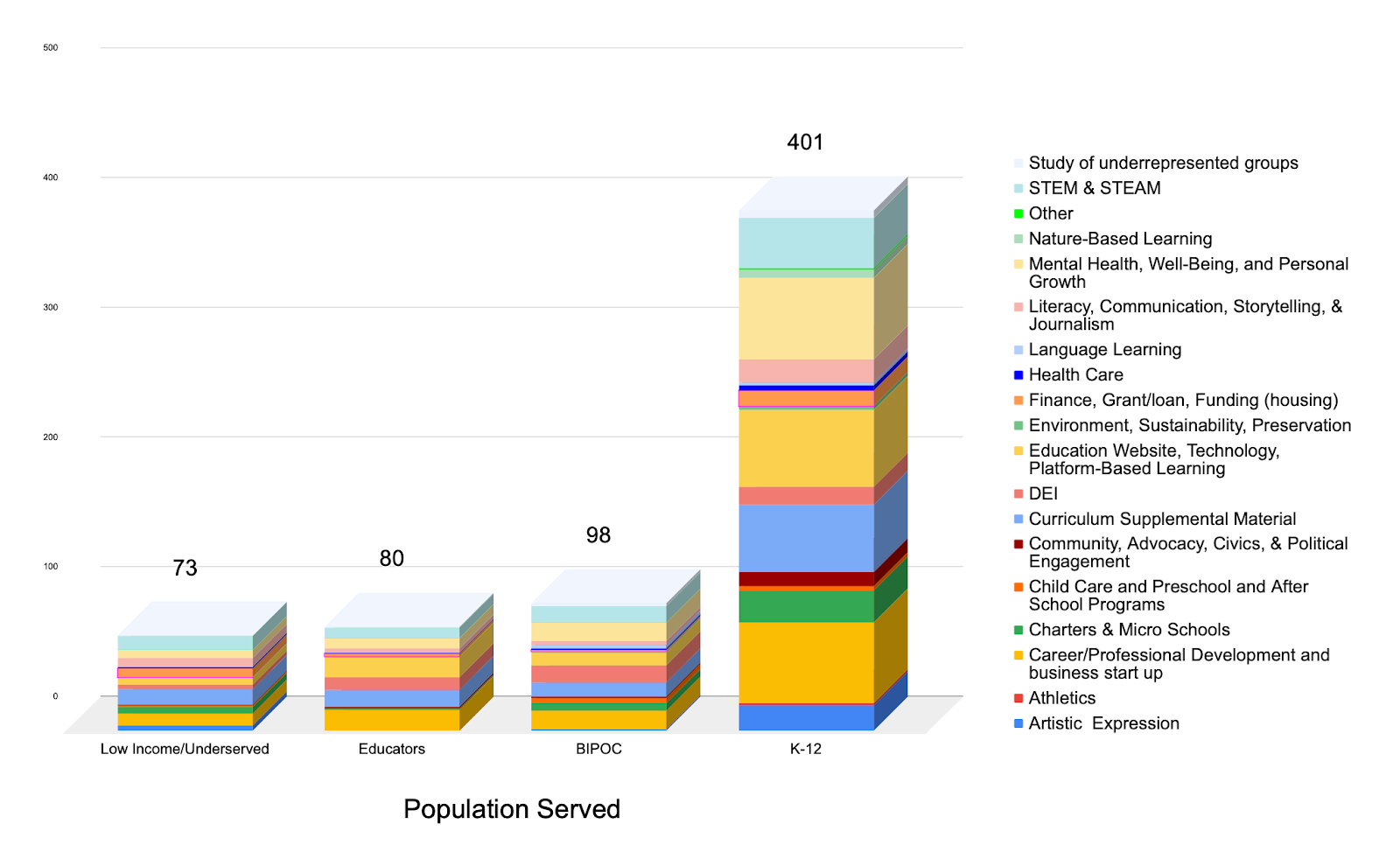What Education Really Needs
Insights from Years of Innovation Applications
.png)
At 4.0, we have a unique vantage point on the future of education.
Every day, innovators from across the country share their boldest ideas with us: ideas born from lived experience, community wisdom, and an unwavering belief that education can and must be better.
Across the country, many school districts are facing tough funding decisions, policy changes, and growing pressure from families who want schools to better meet their children's needs.
In the face of these challenges, education entrepreneurs are stepping up with fresh ideas and new approaches. They're listening to what communities are asking for and working to fill the gaps that traditional systems sometimes leave behind.
This analysis was done in partnership with the University of Delaware. University’s research team systematically coded and analyzed applications submitted to 4.0’s funding programs, distilling the data to surface the audience and innovation themes presented in this brief.
Emerging Themes: Most Common Ideas
After reviewing hundreds of applications, we've identified five powerful themes that show where education innovation is heading.
These aren't just trends, they're a roadmap for transformation, drawn by the very communities most impacted by education's current challenges.
1. Career and Professional Development Are a Top Priority
Entrepreneurs are prioritizing career preparation and professional development ideas that offer real-world learning experiences, skills, and tools to help students understand and navigate diverse career pathways.
These programs often integrate mentorship, resume-building, and technical skills.
Many innovators recognize that students need more than theoretical knowledge, they need practical pathways to meaningful careers.
This isn't about tracking students into predetermined paths; it's about opening doors to possibilities they might never have imagined.
2. New and Creative Ideas for Curriculum and Services
Many ventures aim to reimagine learning content and pedagogy through experiential, project-based, STEM-oriented, and interdisciplinary curriculum.
These designs foster problem-solving, creativity, and adaptability skills critical for career success.
What excites us most is that these aren't incremental improvements to existing curricula, they're complete reimagination of what learning can look like.
We're seeing proposals for curricula that start with community challenges and work backward to academic standards. Programs that blend indigenous knowledge with cutting-edge science, and learning experiences that refuse to separate "academic" from "real world."
These innovators understand that when learning is relevant, rigorous, and rooted in student interests, engagement isn't a problem to solve—it's a natural outcome.
3. Educational Technology and Online Platforms
Startups are leveraging digital platforms and AI-powered learning tools to expand access, personalize instruction, and support hybrid learning environments.
Technology is often positioned not as an end in itself but as a tool for delivering quality teaching and learning.
Whether it's AI tutors that adapt to each student's learning style, platforms that connect rural students with expert mentors worldwide, or tools that help teachers differentiate instruction at scale, these innovations show us technology at its best: amplifying human connection and possibility rather than replacing it.
4. Promoting Student Interest in STEM and STEAM Education
Education entrepreneurs are developing innovative approaches to enhance Science, Technology, Engineering, Agriculture, and Mathematics (STEAM) education in K–12 schools.
These efforts often involve hands-on, interdisciplinary learning experiences that build problem-solving skills and expose students to future career pathways in high-demand fields.
The innovators understand that STEAM isn't just about producing more engineers, it's about cultivating creative problem-solvers who can tackle our world's biggest challenges.
5. Ideas Seek to Advance DEI and Social Justice
Education entrepreneurs are actively working with schools to address systemic discrimination and foster equitable learning environments.
Through research-informed collaboration, some of these equity-focused educational innovations empower schools to critically assess and reform institutional practices that perpetuate inequities. Others focus on integrating social justice education into both in-school and out-of-school settings.
Where Ideas Intersect: Co-Occurrence Trends
Our co-occurrence analysis reveals fascinating patterns in how different innovation themes connect and reinforce each other.

The strongest overlaps are found among:
- Curriculum and supplemental materials with educational technology and platform-based learning
- Mental health and personal growth with career or professional development
- Career development with business start-up initiatives
This pattern suggests that many innovators are thinking holistically, integrating educational technology with curriculum development, career readiness, and student well-being.
We're encouraged to see that innovators aren't thinking in silos, they understand that effective education solutions must address multiple needs simultaneously.
Moderate overlap is observed in categories such as STEM and STEAM, mental health and personal growth, and charters and micro schools, indicating these themes are also commonly linked with other areas of innovation.
In contrast, artistic expression and finance-related topics, such as grants, loans, and housing funding show lower rates of co-occurrence, suggesting these subjects are less frequently combined with other innovation categories in our current applicant pool.
Who Education Innovators Aim to Serve
Most innovations target K–12 students, with a strong emphasis on middle and high schoolers preparing for postsecondary transitions.
A substantial number of startups also support educators, low-income and underserved communities, and BIPOC communities, aiming to strengthen the broader learning ecosystem.

The data paints a clear picture of innovators' priorities: they're focused on the students and communities that traditional systems have too often failed.
We're particularly encouraged by the emphasis on middle and high school students, those critical years when young people are forming their identities and making decisions that shape their futures.
The strong focus on supporting educators alongside students shows a systems-thinking approach we deeply value.
Innovations by Audience: Idea Trends by Audience Subgroup
Our analysis reveals distinct patterns in how innovators are tailoring solutions to specific communities:
K-12 Education
Among innovations targeting K–12 education, the most common approaches focus on strengthening both student learning and teacher effectiveness.
These efforts include the development of educational technology tools to enhance digital learning and classroom engagement, career and professional development programs that prepare students for postsecondary pathways, and mental health services aimed at supporting student well-being.
Additionally, many initiatives provide curriculum and supplemental materials designed to improve instructional quality, as well as STEM and STEAM programs that foster student interest and proficiency in science, technology, engineering, arts, and mathematics.
BIPOC Communities
For initiatives serving BIPOC communities, the most common service types are designed to address systemic disparities and promote empowerment.
These efforts include mental health programs that provide culturally responsive support for emotional well-being, STEM and STEAM initiatives that work to expand access to high-demand fields that aim to create inclusive learning environments and advance social justice.
Educators
Among educator-focused innovations, the most common service types are designed to strengthen instructional practice and support teacher well-being.
These approaches include educational technology tools that enhance lesson delivery and student engagement, curriculum and supplemental materials that offer high-quality, adaptable content, and resources that foster inclusive and equitable classroom environments.
There is also a growing emphasis on mental health supports to address educator burnout and promote wellness, along with STEM and STEAM initiatives that provide training and resources to help teachers inspire student interest and competence in science, technology, engineering, arts, and mathematics.
Closing the Gaps: What Families and Grassroots Innovators Say Education Needs Now
Across the country, families and grassroots innovators are highlighting persistent gaps in education that current systems aren't addressing.
They are calling for solutions that are more flexible, equitable, and responsive to the real needs of students and communities. Here's what they say is missing, and what's needed next:
Relevant, Inclusive Learning
Curricula often fail to reflect local context or diverse backgrounds, leaving many teachers and students disengaged.
We hear this concern repeatedly in applications - the disconnect between what's taught and what matters to communities.
Innovators are responding with curricula that start with community assets and challenges, that honor multiple ways of knowing, and that prepare students for the actual futures they're likely to face.
Whole-Child Support
There is a widespread need for better mental health, safety, and social-emotional supports in schools. This theme appears across nearly every demographic group in our applications.
Families are clear: academic achievement without emotional well-being is a hollow victory.
We're seeing innovative responses that integrate social-emotional learning throughout the day, create trauma-informed school cultures, and provide accessible mental health support that meets students where they are.
Access to Enrichment
Many students, especially in underserved communities, have limited access to extracurricular and out-of-school learning opportunities.
This gap represents not just a loss of learning but a loss of joy, discovery, and identity formation.
Our applicants are creating solutions that bring enrichment into the school day, partner with community organizations to extend learning beyond school walls, and ensure that zip code doesn't determine access to transformative experiences.
Community-Driven Solutions
Most funding and policy changes still overlook grassroots organizations and underfund holistic, equity-focused approaches.
This systemic challenge underlies many of the other gaps. We're proud that 4.0 exists precisely to address this gap, to ensure that those closest to education's challenges have the resources and support to implement their solutions.
Our Path Forward
We see in these applications not just ideas, but movements waiting to be born. Every proposal represents communities saying "we deserve better" and then rolling up their sleeves to create it.
The patterns we've identified: the focus on career readiness, the integration of technology with human connection, the centering of equity and justice, the recognition of mental health as foundational to learning - these aren't just trends. They're a blueprint for education transformation drawn by those who know best what their communities need.
As we continue to review applications and select fellows for our programs, we're using these insights to ensure we're supporting the innovations that matter most.
We're looking for ideas that address these gaps, serve these communities, and integrate these approaches.
Most importantly, we're looking for innovators who understand that transforming education isn't about imposing solutions from outside, it's about unleashing the solutions that already exist within communities.
To everyone who submitted an application: thank you for trusting us with your vision.
To those still developing ideas: we see you, we need you, and we're here to support you.
Together, we're not just improving education, we're reimagining it from the ground up.
Be part of the community
.png)